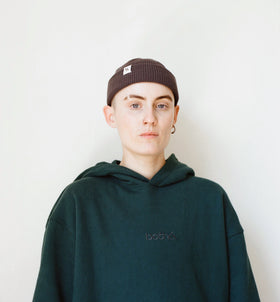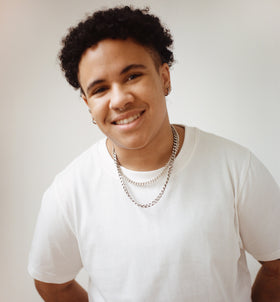
Dec 2, 2021
T-shirts: Tips, Tricks, and Brands.
Finnegan Shepard
How to make a t-shirt ‘work’ as a trans man.
One of the first things that struck me when I started doing interviews for Both& was just how creative people are. It’s no wonder that in a fashion world built off of the binary anyone who doesn’t fit is forced to come up with alternatives. I’ve been doing it my whole life — I guess I just didn’t really realize what I was doing until I started hearing from others about how they make it work.
This piece is the first in what I hope will be on ongoing series, in which I compile and share all of the cool tips and tricks I’ve learned from members of our community, as well as post links to brands or articles of clothing that have been a good solution for some folks. (I realize this may seem counter-intuitive as a business move, but my number one goal is to make shopping as a trans or nonbinary person easier, not to get everyone to shop only at Both&).
So, without further ado, let’s get to it.
T-shirts
The first thing that is helpful to understand when trying to get a t-shirt that fits well for a ftm or masculine-presenting nonbinary person is to think about body shape.
Shapes
All bodies are different, but the most common differences between non cis-male bodies and cis-male bodies are the following:
- Shoulders are more narrow
- Hips are wider
- HRT can move fat from hips and thighs to abdomen (but not always)
- HRT often leads to more muscle development (chest and shoulders)
- Breasts (if no or pre top surgery)
- Proportionally shorter torso (generally)
Conversely, cis-male bodies tend to have wider shoulders than hips, and proportionally longer torsos in relation to arms and legs. To greatly over-exaggerate the challenge, non-cis male bodies tend towards a triangular shape with the wider part at the bottom, while cis-male bodies tend towards an upside down triangular shape.
If you are trying to create more of a cis-male shape, t-shirts can be particularly challenging, because they have less structure than button downs or outerwear, and therefore are the piece of clothing that ‘clings’ the most.
Because cis men tend to have longer torsos and narrower hips, men’s t-shirts most frequently cling or cause problems in two areas:
- They are too tight at the mid-hip.
- They are too long and bunch up, which only adds to the ‘width’ around lower hip region. (Shirts that are traditionally intended to be tucked in, like multi packs of white undershirts and polo shirts are often particularly bad).
That being said, there are a number of ways to make t-shirts fit in a way that is more comfortable and aligned with the shape you want to present.
Tips, Tricks, and Brands
Below are a number of approaches that I or someone I’ve spoken with has used for t-shirts.
- Box shape
One of the most effective methods I’ve used over the years is to look for (or customize) shirts to make more of a box shape, rather than a rectangular one. While more of a boxy shape may not be everyone’s style ideal, it tends to do the best job creating more of the illusion of a square shape.
Finding a good boxy shirt can be challenging. One shirt I’ve found to work particularly well for me is Uniqlo’s U oversized crew neck. The length and width fits my body well, and I like the look of rolling up the oversized shirt sleeves. (More on rolling up sleeves later).
Another DIY option I’ve heard from multiple folks is to buy a shirt in whatever style they like one or two sizes up from their normal size, and then to cut off a few inches at the bottom. That allows them to get the right width throughout, without the wrong proportional for length.
However, one of the problems with the oversized t-shirt approach is that if you are binding, the neck opening for the shirt may not fit snuggly, and consequently the top of the binder might poke out. (This was something that really bothered me while I was binding).
- Tucked shirts
Above, I mentioned that some men’s shirts are made with the intention of being tucked in. There are quite varied opinions about how tucking a shirt can impact perceived shape. Some folks feel that when they tuck a shirt in it is held in place more firmly, which creates more of a straight line between hips and armpits. It can also obscure the division between torso and legs, so that torsos can be made to look proportionally longer.
On the other hand, given that shirts are tucked around the hip area, it can draw extra attention to the hips, which is often something folks are trying to avoid.
Here’s my two cents. Tucking your shirt in can be a good way to create more of a long, square shape if you have narrow hips, if you are using a t shirt with a lot of structure, or if you are layering. Otherwise, it tends to accentuate the narrower shoulders wider hips phenomenon.
- Color
This one is relatively simple.
In general, darker colors are better and black is best if you are trying to avoid the shadows that inevitably emphasize where clothing clings and falls away.
White t-shirts are often see-through. This poses a variety of problems, especially if you are binding. If you want to wear a white t shirt, I recommend going slightly off-white, and looking for one with thicker fabric.
- Structure & layering
This leads to tips around structure and how you can guide the eye to certain areas of your t-shirt/body. As a general rule, super thin cottons or athletic-style t shirts will always cling to whatever part of your body sticks out the most. Some folks I speak to — especially trans men post top surgery who want to emphasize muscle growth in their shoulders and chest — want exactly this, the caveat being that many of these shirts still suffer from the proportionally too long and tight at the hips problem. I’ve heard that Asos has some good options in this arena, but haven’t tried them myself.
If you want to create a simple square shape, your best bet is to layer when its temperature appropriate. The most common forms of this are a button down on top of a t shirt, a t shirt over a tank top or full torso binder, or two t shirts. Some folks also like to layer vests (American version) over shirts. Vests tend to be cut off around the top of the hips and add a bit of straight width, which creates the illusion of a straight line from beneath the armpits down through the hips.
Another method is to try and draw the eye away from areas you are less comfortable with, and towards areas you feel more aligned with. Here are some tips for that:
- Impose structure and bulge where you want people to look. Before top surgery, I liked to find t shirts with sleeves that would hold a rolled-up shape well. I am fond of my arm muscles, and rolling up my t shirt sleeves a) drew the eye away from the chest and to that part of my body, and b) created a bump in the flow of the shirt, so that the bumps around my chest and hips (that I weren’t comfortable with) didn’t stand out as much.
- Buy second hand t-shirts, usually a little oversized. A number of folks I’ve spoken to prefer to buy shirts second hand, because when they are worn in they can droop off of the shoulders in a straight line, rather than clinging to chest or hips.
- Get shirts that have color or fabric details that distract the eye. Henley style shirts literally add a vertical bulge onto the chest, and the fabric tends to be more structured. Baseball style tee’s change color in the transition of upper chest into shoulders, which draws the eye away from the chest and to the shoulders and upper arms.
Okay, I think that’s it for now. If you found value from this article, please share it and send us your tips, tricks, or preferred brands — the more knowledge we can compile as a community, the more we all benefit. Leave a comment, visit our website, or shoot us an email at hello@bothandapparel.com.
Love,
Finnegan and the Both& team




